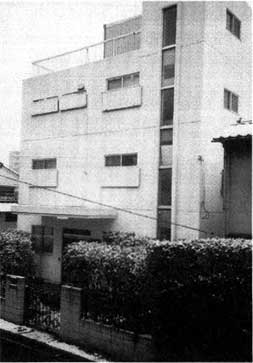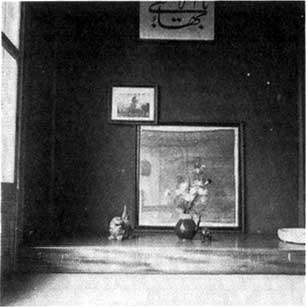
|
Traces That Remain:
A Pictorial History of the Early Days of the Bahá'í Faith among the Japanese
by Barbara R. Sims
edited by Sheridan Sims  |
chapter 53 | start page | single page | chapter 55 |  |
Chapter 54
The Guardian knew that it was difficult for the small but expanding

The Tokyo Haziratu'l-Quds at the time it was purchased by the Local Spiritual Assembly of the Bahá'ís of Tokyo, 1954. It was enlarged and improved through the years.
In 1954 the Guardian wrote to the Local Spiritual Assembly of Tokyo that the matter was urgent and should be accomplished that year. He sent a large personal contribution for this purpose. Hand of the Cause Mrs. Amelia Collins also contributed, as she did for all the Haziratu'l-Quds' which needed to be purchased during the Ten Year Crusade. The National Spiritual Assembly of the Bahá'ís of the United States made a sizeable contribution, as that body had been given responsibility for the development of the Faith in Japan in those early years of the Ten Year Crusade. Of course, all the Bahá'ís in Japan were invited to participate by contributing and according to early records, many were glad to do so. Enough money was raised.
When a search by the Local Spiritual Assembly of Tokyo failed to find a suitable building, a member of the assembly, Mr. Rafaat, offered to sell his modest house to the Tokyo Assembly

click here for larger image
A Bahá'í group in front of the entrance to the Tokyo Haziratu'l-Quds, about 1958. Standing are Mr. Rafaat, Mr. Marangella, Mrs. Hazel Mori (who was visiting Japan), and Mrs. Joy Earl. Kneeling are Mr. Haruo Nekomoto and Mr. Kiyoshi Hashimoto.
A cable was sent to the Guardian after the transaction was completed Dec. 18, 1954. He replied by cable, "Delighted Loving Prayers."
It was the second Haziratu'l-Quds in Japan, and in the Orient. The first was in Amagasaki, Japan, donated by Mr. Noureddin Mumtazi in 1953. The third Haziratu'l-Quds in Japan was in Osaka. In 1958 Mr. Hassan Naderi donated his residence. Through the years the value of the land escalated so greatly that a little over twenty years later, the national assembly found that by selling the original Osaka property, there were enough funds to buy another much needed Haziratu'l-Quds in Osaka, and also build a new Bahá'í Center for Tokyo.
The Tokyo Bahá'í Center, as it was called, had served the Bahá'ís well for twenty-eight years. It had played host to fourteen

The new Tokyo National Haziratu'l-Quds built in 1982 to accommodate the ever-growing Bahá'í community. It was built on the same land as the old Center.

A precious brocade from the Shrine of Bahá'u'lláh hangs in the National Haziratu'l-Quds in Tokyo.The Guardian encouraged the institutions of the Faith to develop their archives. Even as early as 1937 he gave Miss Alexander a photograph of 'Abdu'l-Bahá which he said was for the archives in Japan.
When Mr. Hiroyasu Takano made his pilgrimage in 1954 the Guardian gave him a brocade to take back to Tokyo, a sacred and precious relic which he said had rested immediately over the Remains of Bahá'u'lláh in His Shrine. The Guardian said it should eventually be hung in the Haziratu'l-Quds of the national assembly. As there was no national assembly at the time, the Tokyo Local Spiritual Assembly had it framed and it has been displayed in the Tokyo Hazira ever since.
One time years ago, in 1960, Miss Alexander stayed six weeks in the Tokyo Hazira. We can remember her saying that she felt the brocade had such significance that she loved looking at it and saying her prayers near it. She said, to her, it was the holiest spot in the Orient.
Although the brocade appears to be the whole piece, Mr. Takano recalls the Guardian dividing it into two pieces, one of which went to another country.
In 1982 it was torn down and a handsome three-story building erected on the same land, using the funds from the sale of the Osaka property and special donations from dedicated Bahá'ís.
 |
chapter 53 | start page | single page | chapter 55 |  |
|
|